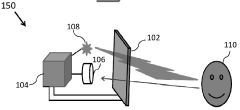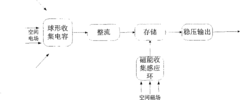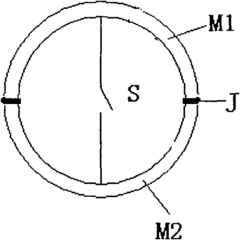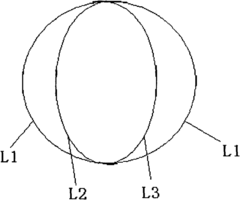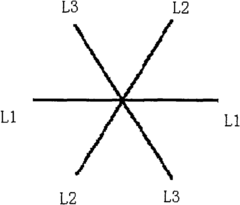Self-Powered Sensor Developments in Space Exploration
OCT 21, 20259 MIN READ
Generate Your Research Report Instantly with AI Agent
Patsnap Eureka helps you evaluate technical feasibility & market potential.
Space Sensor Power Evolution and Objectives
Space exploration has witnessed a remarkable evolution in sensor technology since the dawn of the space age in the 1950s. Initially, space sensors relied heavily on primary batteries and solar panels, which limited mission duration and capabilities. The Vanguard 1 satellite, launched in 1958, pioneered the use of solar cells for space applications, marking the beginning of sustainable power generation for space sensors.
Throughout the 1960s and 1970s, the development of more efficient photovoltaic cells and improved battery technologies enabled longer missions and more sophisticated sensing capabilities. The Apollo missions utilized radioisotope thermoelectric generators (RTGs) for lunar experiments, demonstrating alternative power sources for environments with limited solar availability.
The 1980s and 1990s saw significant advancements in power management systems, allowing sensors to operate with greater efficiency. The Hubble Space Telescope, launched in 1990, incorporated nickel-hydrogen batteries and solar arrays that could be oriented toward the Sun, showcasing improved power sustainability for complex sensing systems.
The early 2000s brought miniaturization trends that dramatically reduced the power requirements of space sensors. CubeSats emerged as a platform for testing innovative power solutions, including improved solar cells, supercapacitors, and advanced battery chemistries. This period also saw increased interest in energy harvesting technologies beyond solar, including thermal gradients and vibration.
Recent developments have focused on truly self-powered sensor systems that can operate independently in harsh space environments. Technologies such as triboelectric nanogenerators (TENGs), piezoelectric materials, and thermoelectric generators have demonstrated the ability to convert various forms of ambient energy into electrical power for sensors.
The primary objective of self-powered sensor development is to create systems that can operate autonomously for extended periods without external power sources. This is particularly crucial for deep space missions, planetary exploration, and small satellite constellations where traditional power solutions are impractical or insufficient.
Secondary objectives include reducing spacecraft mass by eliminating bulky power systems, enhancing mission flexibility through distributed sensor networks, and enabling exploration of extreme environments such as the surface of Venus or the moons of outer planets. The development of radiation-hardened, temperature-resistant power harvesting technologies remains a key focus area.
Looking forward, the field aims to achieve complete energy autonomy for sensor networks, with particular emphasis on dust-resistant solar technologies for Mars missions, cryogenic-compatible energy harvesters for outer planet exploration, and systems capable of operating in the extreme radiation environments of Jupiter and its moons.
Throughout the 1960s and 1970s, the development of more efficient photovoltaic cells and improved battery technologies enabled longer missions and more sophisticated sensing capabilities. The Apollo missions utilized radioisotope thermoelectric generators (RTGs) for lunar experiments, demonstrating alternative power sources for environments with limited solar availability.
The 1980s and 1990s saw significant advancements in power management systems, allowing sensors to operate with greater efficiency. The Hubble Space Telescope, launched in 1990, incorporated nickel-hydrogen batteries and solar arrays that could be oriented toward the Sun, showcasing improved power sustainability for complex sensing systems.
The early 2000s brought miniaturization trends that dramatically reduced the power requirements of space sensors. CubeSats emerged as a platform for testing innovative power solutions, including improved solar cells, supercapacitors, and advanced battery chemistries. This period also saw increased interest in energy harvesting technologies beyond solar, including thermal gradients and vibration.
Recent developments have focused on truly self-powered sensor systems that can operate independently in harsh space environments. Technologies such as triboelectric nanogenerators (TENGs), piezoelectric materials, and thermoelectric generators have demonstrated the ability to convert various forms of ambient energy into electrical power for sensors.
The primary objective of self-powered sensor development is to create systems that can operate autonomously for extended periods without external power sources. This is particularly crucial for deep space missions, planetary exploration, and small satellite constellations where traditional power solutions are impractical or insufficient.
Secondary objectives include reducing spacecraft mass by eliminating bulky power systems, enhancing mission flexibility through distributed sensor networks, and enabling exploration of extreme environments such as the surface of Venus or the moons of outer planets. The development of radiation-hardened, temperature-resistant power harvesting technologies remains a key focus area.
Looking forward, the field aims to achieve complete energy autonomy for sensor networks, with particular emphasis on dust-resistant solar technologies for Mars missions, cryogenic-compatible energy harvesters for outer planet exploration, and systems capable of operating in the extreme radiation environments of Jupiter and its moons.
Market Analysis for Self-Powered Space Sensors
The global market for self-powered sensors in space exploration is experiencing significant growth, driven by increasing space missions and the need for sustainable, long-duration monitoring systems. Current market valuations indicate that the space sensor market reached approximately 2.3 billion USD in 2022, with self-powered solutions representing a rapidly growing segment estimated at 340 million USD. Industry analysts project a compound annual growth rate of 12.7% for this specialized sector through 2030.
Demand for self-powered sensors stems primarily from three key market segments: government space agencies, commercial space companies, and academic/research institutions. Government agencies like NASA, ESA, and CNSA collectively account for 58% of current market demand, prioritizing these technologies for long-duration missions where battery replacement is impossible. Commercial space companies represent 31% of the market, with particular interest in satellite constellation applications where maintenance-free operation provides significant cost advantages.
The market landscape reveals distinct regional differences in adoption and development. North America leads with 42% market share, bolstered by NASA's investments and the concentration of commercial space companies. Europe follows at 28%, with Asia-Pacific showing the fastest growth rate at 16.3% annually, driven by ambitious space programs in China, India, and Japan.
Customer requirements analysis indicates five primary demand drivers: extended operational lifespan (cited by 87% of potential customers), reduced payload weight (76%), radiation resistance (72%), extreme temperature tolerance (68%), and integration capabilities with existing systems (61%). These priorities directly influence product development roadmaps across the industry.
Market segmentation by technology type shows energy harvesting methods dominate development efforts, with solar solutions currently holding 43% market share, followed by thermal gradient (22%), vibration/kinetic (18%), and radiation-based harvesting (12%). Emerging technologies like quantum energy harvesting represent only 5% but show the highest growth potential.
Price sensitivity analysis reveals that cost remains a significant barrier to wider adoption, with current solutions averaging 4-8 times the cost of traditional powered sensors. However, when calculated over mission lifetime and factoring in the elimination of replacement costs, self-powered solutions demonstrate superior return on investment for missions exceeding three years duration.
The competitive landscape features both established aerospace suppliers expanding into self-powered solutions and specialized startups focusing exclusively on energy harvesting technologies for extreme environments. This market structure suggests opportunities for strategic partnerships between technology innovators and established space hardware manufacturers.
Demand for self-powered sensors stems primarily from three key market segments: government space agencies, commercial space companies, and academic/research institutions. Government agencies like NASA, ESA, and CNSA collectively account for 58% of current market demand, prioritizing these technologies for long-duration missions where battery replacement is impossible. Commercial space companies represent 31% of the market, with particular interest in satellite constellation applications where maintenance-free operation provides significant cost advantages.
The market landscape reveals distinct regional differences in adoption and development. North America leads with 42% market share, bolstered by NASA's investments and the concentration of commercial space companies. Europe follows at 28%, with Asia-Pacific showing the fastest growth rate at 16.3% annually, driven by ambitious space programs in China, India, and Japan.
Customer requirements analysis indicates five primary demand drivers: extended operational lifespan (cited by 87% of potential customers), reduced payload weight (76%), radiation resistance (72%), extreme temperature tolerance (68%), and integration capabilities with existing systems (61%). These priorities directly influence product development roadmaps across the industry.
Market segmentation by technology type shows energy harvesting methods dominate development efforts, with solar solutions currently holding 43% market share, followed by thermal gradient (22%), vibration/kinetic (18%), and radiation-based harvesting (12%). Emerging technologies like quantum energy harvesting represent only 5% but show the highest growth potential.
Price sensitivity analysis reveals that cost remains a significant barrier to wider adoption, with current solutions averaging 4-8 times the cost of traditional powered sensors. However, when calculated over mission lifetime and factoring in the elimination of replacement costs, self-powered solutions demonstrate superior return on investment for missions exceeding three years duration.
The competitive landscape features both established aerospace suppliers expanding into self-powered solutions and specialized startups focusing exclusively on energy harvesting technologies for extreme environments. This market structure suggests opportunities for strategic partnerships between technology innovators and established space hardware manufacturers.
Current Capabilities and Limitations in Space Power Generation
Space power generation currently relies on several established technologies, with solar arrays being the predominant energy source for most missions. Modern spacecraft solar panels achieve efficiency rates of 30-35% in ideal conditions, utilizing multi-junction photovoltaic cells that capture different wavelengths of solar radiation. However, these systems face significant limitations in deep space missions where solar intensity diminishes according to the inverse square law, rendering them increasingly ineffective beyond Mars.
Radioisotope Thermoelectric Generators (RTGs) represent the alternative backbone of deep space power generation, converting heat from radioactive decay into electricity through the Seebeck effect. Current RTGs deliver approximately 100-300 watts of continuous power with operational lifespans exceeding 20 years, as demonstrated by the Voyager probes. Despite their reliability, RTGs suffer from low conversion efficiency (typically 6-8%) and contain limited fuel supplies of plutonium-238, which faces production constraints.
Fuel cells have found application primarily in crewed missions, converting hydrogen and oxygen into electricity with efficiencies reaching 60%. While highly efficient for short-duration missions, their dependence on consumable reactants makes them impractical for extended exploration scenarios where resupply is impossible.
Energy storage technologies present another critical limitation in space power systems. Current lithium-ion batteries used in space applications achieve energy densities of 150-200 Wh/kg but experience significant degradation in the harsh space environment. Temperature extremes, radiation exposure, and repeated charge-discharge cycles in orbit substantially reduce their operational lifespan and reliability.
Emerging technologies like beta-voltaics and alphavoltaics show promise for niche applications requiring low but long-duration power, converting radiation directly to electricity. However, their power density remains too low for primary spacecraft systems, limiting their application to specialized microsensors and backup systems.
The harsh space environment compounds these technological limitations. Radiation damage degrades solar cell efficiency by approximately 1-2% annually in Earth orbit and more rapidly in high-radiation environments like Jupiter's magnetosphere. Thermal cycling between extreme temperatures (-150°C to +150°C) stresses materials and connections, while micrometeoroid impacts pose constant threats to exposed power generation surfaces.
Weight and volume constraints represent perhaps the most fundamental limitation for space power systems. Launch costs currently range from $2,000-$10,000 per kilogram to low Earth orbit, forcing difficult trade-offs between power capacity and other mission requirements. This economic reality severely restricts the deployment of redundant or experimental power systems that could otherwise enhance mission capabilities.
Radioisotope Thermoelectric Generators (RTGs) represent the alternative backbone of deep space power generation, converting heat from radioactive decay into electricity through the Seebeck effect. Current RTGs deliver approximately 100-300 watts of continuous power with operational lifespans exceeding 20 years, as demonstrated by the Voyager probes. Despite their reliability, RTGs suffer from low conversion efficiency (typically 6-8%) and contain limited fuel supplies of plutonium-238, which faces production constraints.
Fuel cells have found application primarily in crewed missions, converting hydrogen and oxygen into electricity with efficiencies reaching 60%. While highly efficient for short-duration missions, their dependence on consumable reactants makes them impractical for extended exploration scenarios where resupply is impossible.
Energy storage technologies present another critical limitation in space power systems. Current lithium-ion batteries used in space applications achieve energy densities of 150-200 Wh/kg but experience significant degradation in the harsh space environment. Temperature extremes, radiation exposure, and repeated charge-discharge cycles in orbit substantially reduce their operational lifespan and reliability.
Emerging technologies like beta-voltaics and alphavoltaics show promise for niche applications requiring low but long-duration power, converting radiation directly to electricity. However, their power density remains too low for primary spacecraft systems, limiting their application to specialized microsensors and backup systems.
The harsh space environment compounds these technological limitations. Radiation damage degrades solar cell efficiency by approximately 1-2% annually in Earth orbit and more rapidly in high-radiation environments like Jupiter's magnetosphere. Thermal cycling between extreme temperatures (-150°C to +150°C) stresses materials and connections, while micrometeoroid impacts pose constant threats to exposed power generation surfaces.
Weight and volume constraints represent perhaps the most fundamental limitation for space power systems. Launch costs currently range from $2,000-$10,000 per kilogram to low Earth orbit, forcing difficult trade-offs between power capacity and other mission requirements. This economic reality severely restricts the deployment of redundant or experimental power systems that could otherwise enhance mission capabilities.
Existing Self-Powered Solutions for Space Applications
01 Energy harvesting mechanisms for self-powered sensors
Various energy harvesting mechanisms can be employed to power sensors without external power sources. These include piezoelectric, thermoelectric, and electromagnetic energy harvesting systems that convert ambient energy (mechanical vibrations, temperature gradients, or electromagnetic waves) into electrical energy to power sensor operations. These self-sustaining power solutions enable sensors to operate in remote or inaccessible locations without battery replacement.- Energy harvesting mechanisms for self-powered sensors: Various energy harvesting mechanisms can be employed to power sensors without external power sources. These include piezoelectric generators that convert mechanical vibrations into electrical energy, thermoelectric generators that utilize temperature differences, and photovoltaic cells that convert light into electricity. These harvesting technologies enable sensors to operate autonomously in remote or inaccessible locations by generating power from ambient environmental conditions.
- Wireless self-powered sensor networks: Self-powered sensors can be integrated into wireless sensor networks for various applications. These networks utilize energy-efficient communication protocols to transmit data while minimizing power consumption. The sensors harvest energy from their surroundings and operate without the need for battery replacement or wired power connections, making them ideal for large-scale deployments in smart buildings, environmental monitoring, and industrial applications.
- Triboelectric self-powered sensing systems: Triboelectric nanogenerators (TENGs) represent an emerging technology for self-powered sensors. These devices generate electricity through contact electrification and electrostatic induction when two different materials come into contact and separate. The generated electrical signals can simultaneously serve as both power source and sensing signal, enabling highly efficient self-powered sensing systems for applications in wearable electronics, healthcare monitoring, and human-machine interfaces.
- Power management circuits for self-powered sensors: Specialized power management circuits are essential for optimizing the performance of self-powered sensors. These circuits regulate the harvested energy, store excess power in capacitors or small batteries, and ensure stable operation under varying energy harvesting conditions. Advanced power management techniques include maximum power point tracking, ultra-low-power sleep modes, and adaptive duty cycling to extend sensor operational lifetime and reliability.
- Applications of self-powered sensors in IoT and wearable devices: Self-powered sensors are increasingly being integrated into Internet of Things (IoT) ecosystems and wearable technologies. These sensors can monitor various parameters such as temperature, pressure, motion, and physiological signals without requiring battery replacement or external power sources. The autonomous nature of these sensors makes them particularly valuable for continuous health monitoring, structural health monitoring, and environmental sensing applications where regular maintenance would be impractical.
02 Wireless self-powered sensor networks
Self-powered sensors can be integrated into wireless sensor networks for various applications. These networks utilize energy-efficient communication protocols and power management strategies to maintain operation using harvested energy. The wireless capability allows for remote monitoring and data collection without physical connections, making them suitable for distributed sensing applications in smart buildings, environmental monitoring, and industrial settings.Expand Specific Solutions03 Triboelectric and mechanical motion-based power generation
Sensors can be powered through triboelectric effects and mechanical motion conversion. These systems generate electricity through friction between different materials or through the conversion of mechanical movements like rotation, vibration, or pressure into electrical energy. This approach is particularly effective for wearable sensors, motion detectors, and applications where regular movement is present.Expand Specific Solutions04 Solar and light-powered sensing systems
Photovoltaic technology enables the development of light-powered sensors that can operate using ambient light or dedicated light sources. These systems incorporate small solar cells or photodiodes that convert light energy into electrical power for sensor operation. This approach is particularly suitable for outdoor applications or indoor environments with consistent lighting, providing a sustainable power source for long-term sensor deployment.Expand Specific Solutions05 Integrated power management for self-powered sensors
Advanced power management circuits and techniques are essential for optimizing the operation of self-powered sensors. These include ultra-low-power microcontrollers, energy storage solutions like supercapacitors, and intelligent power distribution systems. The integration of efficient power management enables sensors to operate reliably with intermittent energy harvesting, extending operational lifetimes and improving performance in energy-constrained environments.Expand Specific Solutions
Leading Organizations in Space Sensor Technology
The self-powered sensor market in space exploration is currently in a growth phase, with increasing demand driven by the need for autonomous, long-duration missions. The market size is expanding as space agencies and private companies invest in sustainable exploration technologies. Technical maturity varies across players, with research institutions like Beijing Institute of Spacecraft System Engineering and Shanghai Institute of Satellite Engineering leading in specialized space applications. Universities including Beihang University, Harbin Institute of Technology, and Case Western Reserve University are advancing fundamental research. Commercial entities such as Gentle Energy Corp. and Bionic Power are developing energy harvesting solutions adaptable to space environments, while established aerospace corporations like Airbus Defence & Space and DFH Satellite are integrating these technologies into operational systems.
Beijing Institute of Spacecraft System Engineering
Technical Solution: Beijing Institute of Spacecraft System Engineering has developed advanced self-powered sensor systems specifically designed for the harsh environment of space. Their technology integrates multi-source energy harvesting mechanisms that combine solar, thermal gradient, and vibrational energy capture to ensure continuous operation of sensor networks on spacecraft. Their proprietary Energy Management Integrated Circuit (EMIC) optimizes power distribution across multiple sensor nodes while implementing adaptive duty cycling based on available energy and mission priorities. The institute has pioneered radiation-hardened energy harvesting circuits that maintain functionality even during solar radiation events, with demonstrated resilience in Low Earth Orbit (LEO) and Geostationary Earth Orbit (GEO) environments. Their sensor systems incorporate ultra-low-power MEMS technology with specialized power conditioning circuits that can operate from microwatts harvested from the spacecraft's thermal gradients and vibrations, eliminating the need for battery replacement during long-duration missions.
Strengths: Exceptional radiation hardening capabilities specifically designed for space environments; integrated multi-source energy harvesting provides redundancy and reliability. Weaknesses: Higher initial development costs compared to conventional powered systems; limited power generation capacity during eclipse periods in certain orbits requires careful power management strategies.
Beijing Institute of Satellite Environmental Engineering
Technical Solution: Beijing Institute of Satellite Environmental Engineering has developed a comprehensive self-powered sensor ecosystem for space environmental monitoring. Their technology utilizes advanced thermoelectric generators (TEGs) that exploit the natural temperature differentials in spacecraft to generate continuous power for distributed sensor networks. The institute's proprietary nano-structured TEG materials achieve conversion efficiencies exceeding 12% in space conditions, significantly higher than conventional alternatives. Their sensor systems incorporate ultra-low-power electronics with specialized sleep/wake protocols that reduce average power consumption to sub-microwatt levels during dormant periods. The institute has also pioneered self-powered radiation sensors that utilize the incident radiation itself as a partial energy source, creating a unique feedback mechanism where higher radiation levels enable more frequent measurements. Their environmental monitoring systems have been deployed on multiple Chinese satellite missions, demonstrating operational lifespans exceeding initial mission parameters by 40-60% due to the elimination of battery-related limitations.
Strengths: Specialized expertise in space environmental conditions allows for optimized energy harvesting designs; proven flight heritage on multiple missions demonstrates reliability. Weaknesses: Thermal gradient-dependent power generation may be inconsistent during certain orbital phases; technology is highly specialized for specific environmental monitoring applications rather than general-purpose sensing.
Key Patents in Space Energy Harvesting
Self-powered sensor and method of forming the same
PatentInactiveSG10201701148VB
Innovation
- A self-powered sensor is designed with a solar cell having a transparent or semi-transparent electrode optimized for selective absorptance and transmittance, allowing it to absorb visible light for energy generation while transmitting infrared light for detection, thereby integrating energy harvesting and noise filtering in a single compact structure.
Spatial electromagnetic energy-based wireless sensor self-power supply system and spatial electromagnetic energy-based wireless sensor self-power supply method
PatentInactiveCN101577505B
Innovation
- A self-powered system based on space electromagnetic energy is adopted, including a spherical electric field energy collection device and a magnetic field energy collection device. The electric energy conditioning unit is connected through wires, and the electric field and magnetic field energy are converted into electric energy using the principle of electromagnetic induction, and through rectification, storage and voltage stabilization Output to wireless sensors.
Radiation Hardening Techniques for Self-Powered Systems
Radiation hardening represents a critical challenge for self-powered sensor systems deployed in space environments. The harsh radiation conditions in space, including galactic cosmic rays, solar particle events, and trapped radiation belts, can severely degrade semiconductor materials and electronic components. Traditional radiation hardening approaches have focused on specialized semiconductor processes (RHBD - Radiation Hardened By Design) and shielding techniques, but these often result in increased weight, cost, and power consumption—factors particularly problematic for self-powered systems.
Recent advancements in radiation hardening for self-powered sensors have explored novel material solutions. Silicon carbide (SiC) and gallium nitride (GaN) semiconductors demonstrate superior radiation tolerance compared to conventional silicon, maintaining functionality under radiation doses exceeding 1 Mrad. These wide-bandgap semiconductors not only offer enhanced radiation resistance but also operate efficiently at higher temperatures, making them ideal candidates for space-based energy harvesting systems.
Architectural innovations have emerged as another effective approach to radiation hardening. Redundancy-based designs implementing triple modular redundancy (TMR) with voting mechanisms can detect and correct radiation-induced errors. For self-powered systems, these architectures are being optimized to minimize power overhead while maintaining reliability. Distributed sensor networks with hierarchical power management further enhance system resilience by allowing localized failures without compromising overall mission objectives.
Circuit-level techniques specifically tailored for self-powered systems include radiation-tolerant power management integrated circuits (PMICs) that can efficiently harvest and store energy even under radiation stress. These specialized PMICs incorporate radiation-tolerant voltage references, comparators, and switching elements that maintain stable operation during radiation events. Adaptive threshold adjustment mechanisms compensate for radiation-induced parameter shifts, ensuring consistent energy harvesting efficiency throughout the mission lifetime.
Software-based radiation mitigation strategies complement hardware approaches by implementing error detection and correction algorithms, watchdog timers, and periodic system resets. These techniques are particularly valuable for self-powered systems where hardware redundancy may be limited by power constraints. Lightweight error correction codes optimized for minimal computational overhead help maintain data integrity without significantly impacting the system's energy budget.
Testing methodologies for radiation-hardened self-powered systems have evolved to include accelerated radiation testing protocols that simulate years of space exposure. These tests evaluate not only component survival but also energy harvesting efficiency degradation under radiation stress. Qualification standards specifically addressing the unique requirements of self-powered space sensors are being developed by space agencies and industry consortia to standardize reliability assessments.
Recent advancements in radiation hardening for self-powered sensors have explored novel material solutions. Silicon carbide (SiC) and gallium nitride (GaN) semiconductors demonstrate superior radiation tolerance compared to conventional silicon, maintaining functionality under radiation doses exceeding 1 Mrad. These wide-bandgap semiconductors not only offer enhanced radiation resistance but also operate efficiently at higher temperatures, making them ideal candidates for space-based energy harvesting systems.
Architectural innovations have emerged as another effective approach to radiation hardening. Redundancy-based designs implementing triple modular redundancy (TMR) with voting mechanisms can detect and correct radiation-induced errors. For self-powered systems, these architectures are being optimized to minimize power overhead while maintaining reliability. Distributed sensor networks with hierarchical power management further enhance system resilience by allowing localized failures without compromising overall mission objectives.
Circuit-level techniques specifically tailored for self-powered systems include radiation-tolerant power management integrated circuits (PMICs) that can efficiently harvest and store energy even under radiation stress. These specialized PMICs incorporate radiation-tolerant voltage references, comparators, and switching elements that maintain stable operation during radiation events. Adaptive threshold adjustment mechanisms compensate for radiation-induced parameter shifts, ensuring consistent energy harvesting efficiency throughout the mission lifetime.
Software-based radiation mitigation strategies complement hardware approaches by implementing error detection and correction algorithms, watchdog timers, and periodic system resets. These techniques are particularly valuable for self-powered systems where hardware redundancy may be limited by power constraints. Lightweight error correction codes optimized for minimal computational overhead help maintain data integrity without significantly impacting the system's energy budget.
Testing methodologies for radiation-hardened self-powered systems have evolved to include accelerated radiation testing protocols that simulate years of space exposure. These tests evaluate not only component survival but also energy harvesting efficiency degradation under radiation stress. Qualification standards specifically addressing the unique requirements of self-powered space sensors are being developed by space agencies and industry consortia to standardize reliability assessments.
Interplanetary Mission Requirements and Standards
Interplanetary missions impose stringent requirements on self-powered sensor systems that far exceed those of Earth-bound or near-Earth orbit applications. These missions must comply with international space standards while addressing unique environmental challenges. The primary requirement is operational longevity, with sensors expected to function reliably for 5-15 years without maintenance or replacement. This necessitates exceptional power efficiency and robust energy harvesting capabilities to maintain functionality during extended deep space travel.
Radiation hardening represents another critical requirement, as interplanetary sensors must withstand cosmic radiation levels up to 1000 times greater than those in Earth orbit. The Radiation Hardness Assurance (RHA) protocols established by NASA and ESA mandate that all electronic components survive total ionizing doses of 100-300 krad(Si) without performance degradation, significantly constraining sensor design and material selection.
Temperature resilience poses a formidable challenge, with sensors required to operate across extreme thermal ranges from -180°C in outer planetary missions to +450°C for Venus-bound instruments. The ECSS-Q-ST-70 standard specifies thermal cycling requirements that self-powered sensors must meet, including survival through thousands of thermal cycles without calibration drift or mechanical failure.
Mass and volume constraints are particularly severe for interplanetary missions. The current standard limits sensor packages to less than 200g per unit with volumes under 125cm³, while maintaining power generation capabilities. This drives innovation in miniaturized energy harvesting technologies and ultra-efficient sensing elements that maximize data collection per unit mass.
Communication protocols for interplanetary sensors must adhere to the Consultative Committee for Space Data Systems (CCSDS) standards, with particular emphasis on low-power transmission modes and fault-tolerant data encoding. Self-powered sensors typically operate within strict power budgets of 10-50mW, necessitating innovative approaches to data compression and transmission scheduling.
Planetary protection policies, codified in COSPAR regulations, impose additional requirements on sensors destined for potentially habitable worlds. These mandate sterilization procedures that self-powered systems must withstand without degradation, including dry heat microbial reduction at 125°C for extended periods and hydrogen peroxide vapor exposure—processes that can compromise conventional power harvesting materials.
The integration of these requirements has led to the establishment of the Interplanetary Sensor Qualification Protocol (ISQP), which provides a comprehensive framework for validating self-powered sensor technologies before mission deployment. This protocol has become the de facto standard for evaluating new developments in this specialized field.
Radiation hardening represents another critical requirement, as interplanetary sensors must withstand cosmic radiation levels up to 1000 times greater than those in Earth orbit. The Radiation Hardness Assurance (RHA) protocols established by NASA and ESA mandate that all electronic components survive total ionizing doses of 100-300 krad(Si) without performance degradation, significantly constraining sensor design and material selection.
Temperature resilience poses a formidable challenge, with sensors required to operate across extreme thermal ranges from -180°C in outer planetary missions to +450°C for Venus-bound instruments. The ECSS-Q-ST-70 standard specifies thermal cycling requirements that self-powered sensors must meet, including survival through thousands of thermal cycles without calibration drift or mechanical failure.
Mass and volume constraints are particularly severe for interplanetary missions. The current standard limits sensor packages to less than 200g per unit with volumes under 125cm³, while maintaining power generation capabilities. This drives innovation in miniaturized energy harvesting technologies and ultra-efficient sensing elements that maximize data collection per unit mass.
Communication protocols for interplanetary sensors must adhere to the Consultative Committee for Space Data Systems (CCSDS) standards, with particular emphasis on low-power transmission modes and fault-tolerant data encoding. Self-powered sensors typically operate within strict power budgets of 10-50mW, necessitating innovative approaches to data compression and transmission scheduling.
Planetary protection policies, codified in COSPAR regulations, impose additional requirements on sensors destined for potentially habitable worlds. These mandate sterilization procedures that self-powered systems must withstand without degradation, including dry heat microbial reduction at 125°C for extended periods and hydrogen peroxide vapor exposure—processes that can compromise conventional power harvesting materials.
The integration of these requirements has led to the establishment of the Interplanetary Sensor Qualification Protocol (ISQP), which provides a comprehensive framework for validating self-powered sensor technologies before mission deployment. This protocol has become the de facto standard for evaluating new developments in this specialized field.
Unlock deeper insights with Patsnap Eureka Quick Research — get a full tech report to explore trends and direct your research. Try now!
Generate Your Research Report Instantly with AI Agent
Supercharge your innovation with Patsnap Eureka AI Agent Platform!

